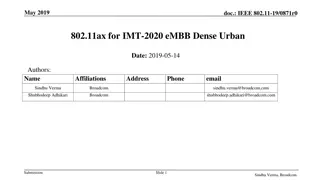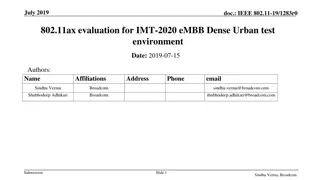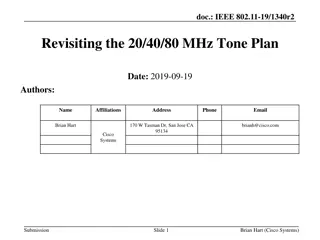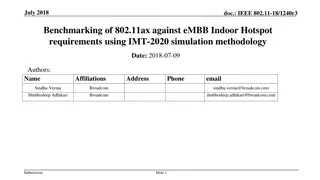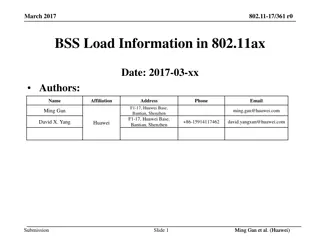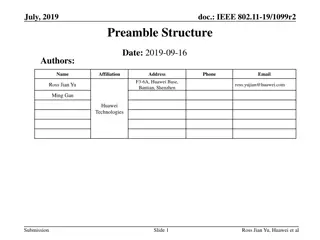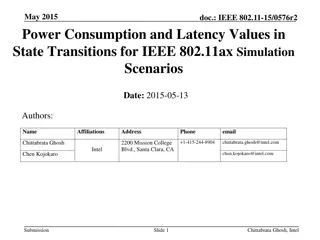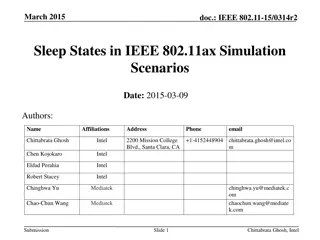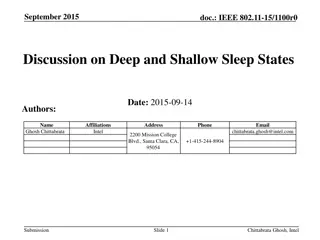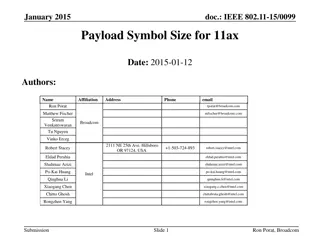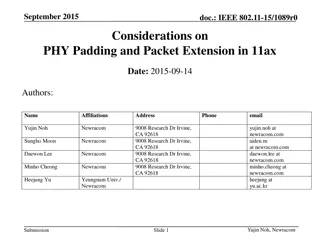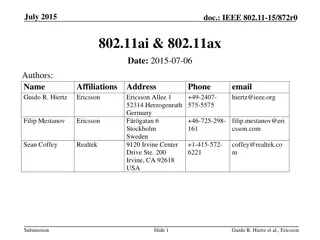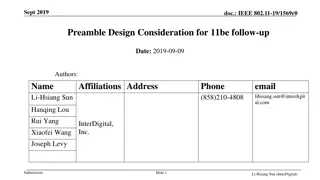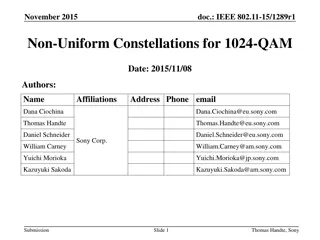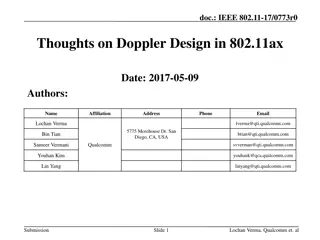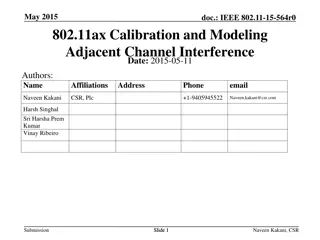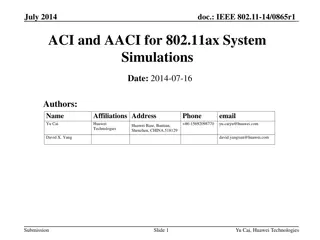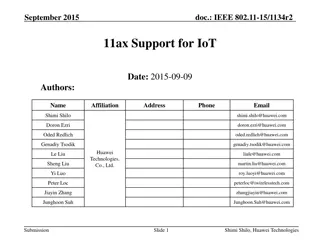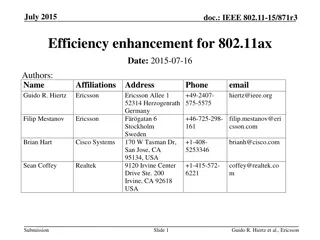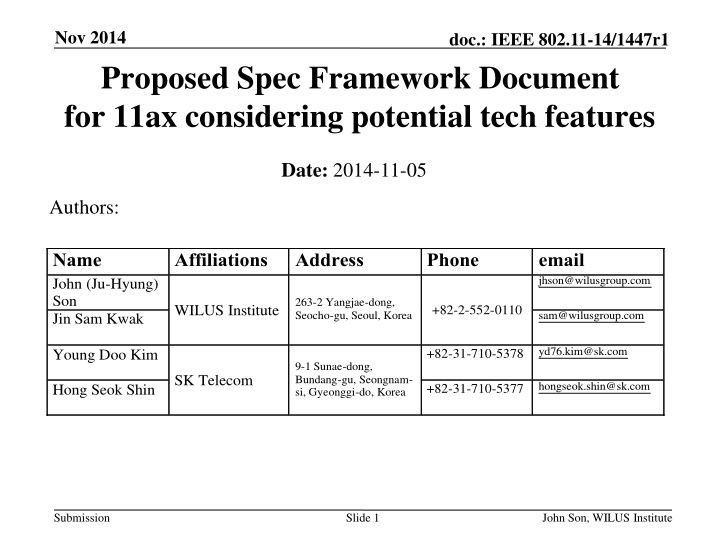
IEEE 802.11ax Potential Tech Features and Framework Overview
Explore the potential technical features proposed for IEEE 802.11ax in the Nov. 2014 document. The document outlines discussions on sub-channel granularity, synchronization, MU-MIMO support, signaling procedures, and more. Stay informed about high-level agreements and ongoing debates shaping the future of wireless communications.
Download Presentation

Please find below an Image/Link to download the presentation.
The content on the website is provided AS IS for your information and personal use only. It may not be sold, licensed, or shared on other websites without obtaining consent from the author. If you encounter any issues during the download, it is possible that the publisher has removed the file from their server.
You are allowed to download the files provided on this website for personal or commercial use, subject to the condition that they are used lawfully. All files are the property of their respective owners.
The content on the website is provided AS IS for your information and personal use only. It may not be sold, licensed, or shared on other websites without obtaining consent from the author.
E N D
Presentation Transcript
Nov 2014 doc.: IEEE 802.11-14/1447r1 Proposed Spec Framework Document for 11ax considering potential tech features Date: 2014-11-05 Authors: Name John (Ju-Hyung) Son Jin Sam Kwak Affiliations Address Phone email jhson@wilusgroup.com 263-2 Yangjae-dong, Seocho-gu, Seoul, Korea WILUS Institute +82-2-552-0110 sam@wilusgroup.com yd76.kim@sk.com +82-31-710-5378 Young Doo Kim 9-1 Sunae-dong, Bundang-gu, Seongnam- si, Gyeonggi-do, Korea SK Telecom hongseok.shin@sk.com +82-31-710-5377 Hong Seok Shin Submission Slide 1 John Son, WILUS Institute
Nov 2014 doc.: IEEE 802.11-14/1447r1 Introduction TGax agreed on the timeline [1] that starts SFD discussions from this November meeting. We propose a skeleton of 11ax SFD considering the previous 11ac SFD[2] and the potential tech features contributed for 11ax. Submission Slide 2 John Son, WILUS Institute
Nov 2014 doc.: IEEE 802.11-14/1447r1 Recap: ToC of the 11ac SFD [2] 1 Definitions 2 Abbreviations and acronyms 3 VHT Physical Layer 4 DL MU-MIMO and Transmit Beamforming 5 Coexistence 6 MAC 11ac Ad Hoc groups 11ac tech features DL MU-MIMO PHY Wide BW MU-MIMO 256 QAM COEX TxBF simplification MAC In 11ac SFD, along with mandatory PHY & MAC sections, additional sections were allocated for newly introduced major technical features Therefore, in order to sketch 11ax SFD skeleton properly, we need to consider potential tech. features for 11ax. Submission Slide 3 John Son, WILUS Institute
Nov 2014 doc.: IEEE 802.11-14/1447r1 Potential tech features for 11ax Potential tech features High-level agreement On-going discussions Granularity of sub-channel BW [7][19] Signaling of STA & sub-CH [14] ACK procedure [11][16][20] Channel access rules [5][6][13] OFDM symbol alignment between sub-CHs [11] DL OFDMA Support DL OFDMA UL OFDMA/ UL MU-MIMO Frequency, Time, Power Synchronization [1][2][3][5][6][10] Scheduling/Signaling [3][4][5][7][8][9][11][12] - CP length options for outdoor support [1][2][5][6][7] Frequency offset increase [2][3] Mid-packet CCA, PAPR problem [3] Signaling of OFDM symbol duration & CP length [4] Coping with outdoor channel variations [5] Support 256 FFT on 20MHz OFDM/Outdoor Dynamic[1~10][40][42], Per-Link[36][39] CCA changes Use with Transmit Power Control [11][13][15][21][23][34] Adoption of 11ah s BSS color [18][20][25][32][33][28] Legacy fairness [15][22][33][34][35] Interferences [34][41], Considering channel-width [37] CCA Support increased CCA Power save model for real time traffic [3] Considering Energy source model [9] Energy Efficiency Among the various tech contributions, we think that the above features are actively discussed in 11ax (see per-feature references at the end of this slide) - Submission Slide 4 John Son, WILUS Institute
Nov 2014 doc.: IEEE 802.11-14/1447r1 (Proposed) ToC for 11ax SFD (Potential) 11ax tech features (Potential) 11ax Ad Hoc groups 1 Definitions 2 Abbreviations and acronyms 3 HE Physical Layer 4 Multi User Support 5 Coexistence 6 MAC Layer DL OFDMA PHY UL OFDMA/ UL MU-MIMO Multiuser OFDM/Outdoor Spatial Reuse CCA MAC Energy Efficiency By considering the potential tech features in the previous slide and the ad hoc group structure discussion in [3], we propose the above ToC for the 11ax Spec Framework Document. Submission Slide 5 John Son, WILUS Institute
Nov 2014 doc.: IEEE 802.11-14/1447r1 Meeting the 11ax Func. Req. [4] The current set of potential tech features will contribute to meet the functional requirements of 11ax 11ax Func. Req. (Performance & Efficiency) 11ax Potential Tech. R1: 4X avg. tput per STA, power efficiency DL OFDMA UL OFDMA/ UL MU-MIMO OFDM/Outdoor R2: desirable latency (dense scenario) R3: spectrum efficiency, OBSS interference mgmt. CCA R4: spectral efficiency with presence of legacy devices Energy Efficiency R5: frequency reuse efficiency, interference mgmt. when high density, direct comm. Submission Slide 6 John Son, WILUS Institute
Nov 2014 doc.: IEEE 802.11-14/1447r1 Potential Tech. Requirements for 11ax SFD 3 HE Physical Layer 3.1 HE OFDM Modulation 3.1.A: The draft specification shall include support of 256 FFT-based OFDM modulation for 20 MHz channel operation. 4 Multi User Support 4.1 DL OFDMA R4.1.A: The draft specification shall include support of DL OFDMA. 5 Coexistence 5.1 Spatial Reuse R5.1.A: The draft specification shall include support of CCA level adjustment for HE STA. 6 MAC Layer Based on the high-level agreements for each potential tech feature, the above technical requirements can be added into SFD later. Submission Slide 7 John Son, WILUS Institute
Nov 2014 doc.: IEEE 802.11-14/1447r1 Conclusions It is important to establish a systematic skeleton in 11ax SFD in order to contain the current technical agreements properly. Based on the analysis of previous technical discussions, we proposed the 11ax SFD skeleton as follows 3 HE Physical Layer 4 Multi User Support 5 Coexistence 6 MAC Layer Submission Slide 8 John Son, WILUS Institute
Nov 2014 doc.: IEEE 802.11-14/1447r1 References [1] [14/0649r1] 802.11ax Timeline Scenario (Qualcomm) [2] [09/0992r21] 11ac Spec Framework Document [3] [14/1184r2] TGax Ad Hoc Structure Discussion (Broadcom) [4] [14/1009r2] 11ax Functional Requirement Submission Slide 9 John Son, WILUS Institute
Nov 2014 doc.: IEEE 802.11-14/1447r1 Ref. - DL OFDMA OFDMA benefits [1] [10/0317r1] DL-OFDMA for Mixed Clients (Cisco) [2] [13/0871r0] Discussion on Potential Techniques for HEW (Renesas Mobile) [3] [14/0855r0] Techniques for Short Downlink Frames (Cisco) OFDMA s efficient channel usages [4] [13/0539r0] Efficient Frequency Spectrum Utilization (LGE) [5] [13/1058r0] Efficient wider bandwidth operation (LGE) [6] [14/1437r1] Efficient Wider Bandwidth Operation in IEEE 802.11ax (Yonsei Univ.) Technical issues/solutions [7] [13/1382r0] Discussion on OFDMA in HEW (LGE) [8] [14/0839r1] Discussion on OFDMA in IEEE 802.11ax (Yonsei Univ.) [9] [14/1208r1] MAC considerations on 802.11ax OFDMA (Yonsei Univ.) [10] [14/1209r1] Multiple RF operation for 802.11ax OFDMA (Yonsei Univ.) [11] [14/1210r1] HEW PPDU Format for Supporting MIMO-OFDMA (Newracom) [12] [14/1211r0] Ack Procedure for OFDMA (Newracom) [13] [14/1417r0] HEW PPDU Transmission Discussion (Newracom) [14] [14/1428r0] Clear Channel Assessment for OFDMA PHY (NTU) [15] [14/1433r0] Protocol and signaling framework for OFDMA (Quantenna) [16] [14/1442r1] Considerations on DL OFDMA control mechanism (Yonsei Univ.) Performance analysis [17] [14/0858r1] Analysis on Frequency Selective Multiplexing in WLAN Systems (Samsung) [18] [14/1169r2] Comparisons of Simultaneous Downlink Transmissions (Interdigital) [19] [14/1227r3] OFDMA Performance Analysis (MediaTek) [20] [14/1436r0] Overhead Analysis for Simultaneous Downlink Transmissions (Interdigital) [21] [14/1452r0] Frequency selective scheduling in OFDMA (Ericsson) Submission Slide 10 John Son, WILUS Institute
Nov 2014 doc.: IEEE 802.11-14/1447r1 Ref. - UL OFDMA/UL MU-MIMO UL MU-MIMO [1] [09/0852r0] UL MU-MIMO for 11ac (Qualcomm) [2] [09/1036r0] Uplink MU-MIMO sensitivity to power differences and synchronization errors (Qualcomm) [3] [13/1388r0] UL MU-MIMO Transmissions (LGE) Technical issues/solutions [4] [14/0598r0] Uplink multi-user MAC protocol for 11ax (KIT) [5] [14/0802r0] Consideration on UL MU transmission (LGE) [6] [14/0818r1] Synchronization Requirements (ZTE) [7] [14/1190r2] Frame Exchange Control for Uplink Multi-user transmission (ZTE) [8] [14/1232r1] On Multi-STA Aggregation Mechanism in 11ax (Newracom) [9] [14/1431r1] Issues on UL-OFDMA (Newracom) [10] [14/1446r0] Analysis of frequency and power requirements for UL-OFDMA (Ericsson) Code-based Multiple Access [11] [14/0616r0] CSMA/CA enhancements (ZTE) [12] [14/1681r1] 802.11 Tgax PHY Frame Structure Discussion for Enabling New Contention Mechanism (ZTE) Submission Slide 11 John Son, WILUS Institute
Nov 2014 doc.: IEEE 802.11-14/1447r1 Ref. - OFDM/Outdoor OFDM Numerology [1] [14/0804r1] Envisioning 11ax PHY Structure Part I (LGE) [2] [14/0801r0] Envisioning 11ax PHY Structure Part II (LGE) [3] [14/1228r2] Issues on 256-FFT per 20MHz (Newracom) [4] [14/1229r1] Dynamic OFDM Symbol Duration (MediaTek) Outdoor Support [5] [13/0536r0] HEW SG PHY Considerations For Outdoor Environments (LGE) [6] [13/0843r0] Further evaluation on outdoor Wi-Fi (LGE) [7] [14/1439r0] Preamble Considerations in Large Channel Delay Spread Scenarios (Newracom) Submission Slide 12 John Son, WILUS Institute
Nov 2014 doc.: IEEE 802.11-14/1447r1 Ref. CCA (1/2) DSC & DSC simulations [1] [13/1012r4], [2] [13/1290r1], [3] [13/1487r2], [4] [13/1489r5], [5] [14/0045r2], [6] [14/0058r1], [7] [14/0294r0], [8] [14/0382r2], [9] [14/0635r1], [10] [14/0779r2] Dynamic Sensitivity Control (DSP Group) [11] [14/0523r0] MAC simulation results for DSC and TPC (Orange) [12] [14/0854r0] DSC and Legacy Coexistence (Sony) [13] [14/0868r1] UL & DL DSC and TPC MAC Simulations (Ericsson) [14] [14/1171r1] DSC Simulation Results for Scenario 3 (Sony) [15] [14/1207r1] OBSS Reuse mechanism which preserves fairness (Orange) [16] [14/1426r2] DSC and legacy coexistence (Ericsson) [17] [14/1427r2] DSC Performance (Ericsson) CCA simulations [18] [14/0082r0] Improved Spatial Reuse Part I (Broadcom) [19] [14/0083r0] Improved Spatial Reuse Part II (Broadcom) [20] [14/0372r2] System level simulations on Increased spatial reuse (Marvell) [21] [14/0578r0] Residential Scenario CCA/TPC Simulation Discussion (InterDigital) [22] [14/0832r0] Performance Evaluation of OBSS Densification (Intel) [23] [14/0833r0] Residential Scenario Sensitivity and Transmit Power Control Simulation Results (InterDigital) [24] [14/0846r1] CCA Study in Residential Scenario (Qualcomm) [25] [14/0861r0] Impact of CCA adaptation on spatial reuse in dense residential scenario (Nokia) [26] [14/0889r3] Performance Gains from CCA Optimization (Broadcom) [27] [14/1199r1] CCA Study in Residential Scenario - Part 2 (Qualcomm) [28] [14/1403r0] Performance Analysis of BSS Color and DSC (Sony) [29] [14/1443r0] Adapting CCA and Receiver Sensitivity (Nokia) Submission Slide 13 John Son, WILUS Institute
Nov 2014 doc.: IEEE 802.11-14/1447r1 Ref. CCA (2/2) CCA measurements [30] [14/0629r0] Measurements on CCA Thresholds in OBSS Environments (WILUS Institute) [31] [14/1416r1] Observed Protocol Violations Caused by DSC for Roaming STAs (Aruba) BSS Color concept [32] [13/1207r1] CID 205 BSSID Color Bits (Broadcom) [33] [14/0847r1] Further Considerations on Enhanced CCA for 11ax (WILUS Institute) Technical issues/solutions [34] [14/0637r0] Spatial Reuse and Coexistence with Legacy Devices (MediaTek) [35] [14/0856r1] Evaluating Dynamic CCA/Receiver Sensitivity Algorithms (Cisco) [36] [14/0872r0] A Protocol Framework for Dynamic CCA (Realtek) [37] [14/0880r1] Increased Network Throughput with TX Channel Width Related CCA and Rules (MediaTek) [38] [14/1225r1] Considerations on CCA for OBSS Operation in 802.11ax (Huawei) [39] [14/1224r0] Link Aware CCA (Cisco) [40] [14/1233r2] Adaptive CCA for 11ax (Newracom) [41] [14/1435r0] Considerations on OBSS Spatial Reuse (MediaTek) [42] [14/1448r1] Considerations for Adaptive CCA (Newracom) Submission Slide 14 John Son, WILUS Institute
Nov 2014 doc.: IEEE 802.11-14/1447r1 Ref. - Energy Efficiency PAR discussions [1] [13/1333r0] Power Efficiency PAR Requirements (Covariants) [2] [14/0026r1] thoughts on hew par (Apple) Technical issues/solutions [3] [14/0352r0] Discussion on power save mode for real time traffic (LGE) [4] [14/0373r1] Energy Efficiency in HEW (Southeast Univ.) [5] [14/1454r1] Power Save Discussion (Nokia) Evaluation Methodologies [6] [14/0827r3] Energy Efficiency Evaluation Methodology (Apple) [7] [14/1161r3] Parameters for Power Save Mechanisms (Apple) [8] [14/1162r1] Energy Efficiency Evaluation Methodology Follow Up (Apple) [9] [14/1444r1] Energy Efficiency Evaluation and Simulation Model (MediaTek) Submission Slide 15 John Son, WILUS Institute

